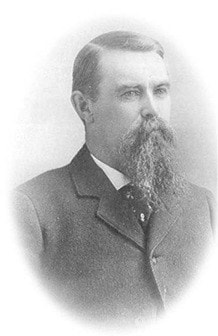Like the mythical phoenix, Haslam rose from the ashes — once. The second time, he wasn’t so lucky.
Upon his death in 1923, aged 77 years, pioneer Nanaimo lumberman Andrew Haslam left a wife, three sons, a landmark home and — maybe — his name on local maps. Even without Cassidy’s Haslam Creek, however, it’s not an altogether unworthy legacy for this man of “enterprise and energy” who’d known as many ups and downs as he had in his career.
Like the mythical phoenix, Haslam rose from the ashes — once. The second time, he wasn’t so lucky.
The son of a northern Ireland customs officer, Haslam emigrated to New Brunswick when 15 years old. Unlike so many others of his generation and national origin, he’d enjoyed what was said to have been a full education, and quickly found work in Fort Garry, precursor to Winnipeg. From the lumber business he moved on to bridge building and sawmilling for two years in Texas before coming to B.C. in 1876.
It’s recorded that his departure from the Lone Star State was motivated more by the fear of yellow fever than the promise of fame and fortune here. But he immediately recognized the potential of our immense forests and joined in a sawmill partnership in New Westminster. He and partners Hendry, McNair and Kelly operated a box factory, then established a small sawmill and sash and door factory in Nanaimo.
Under the umbrella of the parent Royal City Planing Mills Co., they purchased the existing Nanaimo Sawmills Co. in 1885. Haslam separated from his mainland associates a year later and, with A.E. Lees, bought the Nanaimo operation. Within four years, Lees had moved on and Haslam, unencumbered by partnerships it would seem, did well enough to be able to dabble in civic affairs. Upon the death of the area’s MLA, Robert Dunsmuir, in the spring of ’89, he offered himself to fill the legislative vacancy. He won a second, full term by acclamation and served as the people’s representative until defeated three years later.
Looking very much the successful businessmen with his full beard and distinguished bearing, Haslam — between his business and his Conservative, Presbyterian and Masonic diversions — built himself a mansion. Naming it Haslam Hall, he paid what was then an outlandish $6,000 and as much to build two other fine, but smaller, houses.
Through the ’90s and into the new century, Haslam continued to prosper and to expand his mill’s capabilities, including shingles, sashes and doors, even a shipyard, while involving himself in local politics. Having served one and a-half terms as MLA, three terms on New Westminster’s city council, twice as mayor of Nanaimo and two years as MP, the political dilettante might well have been pleased with himself for having come so far since his arrival in the province a quarter of a century before.
It was, alas, too good to continue indefinitely. In 1904 his sawmill was destroyed by fire. The fact that he had to finance reconstruction himself suggests that he’d been under-insured, and when, shortly upon resuming operations, it was devastated by a second fire, Andrew Haslam was all but ruined.
He soon bounced back, at least to a degree, when given the opportunity to establish the province’s log scaling department. By 1923, he was living in Vancouver and it’s there that he died. His fine home at the corner of Nanaimo’s Wallace and Comox roads survived as a city landmark for more than three-quarters of a century until demolished in the 1970s.
By then Haslam was all but forgotten in the Hub City. He does enjoy immortality on provincial maps, however, Powell River’s Haslam Lake and Haslam Lake Provincial Park bearing his name. It’s unlikely that Cassidy’s Haslam Creek, which crosses the Island Highway just north of the Nanaimo Airport, honours this sawmilling giant.
Rather, it probably recognizes the Haslam family, Richard and Nancy Haslam who purchased 100-acre Cedar Farm (hence Haslam Road) in the 1860s. Poor Richard’s one of those unsung heroes who did the work of two men while trying to create a homestead for his family by working as a miner in Nanaimo during the week, and hiking home to work the farm on weekends.
His great labours came to an untimely end, Sept. 30, 1874, when on the job in the Newcastle Mine.
Andrew Haslam had a more lasting and more successful career on the local stage, even if it did end in ashes.
